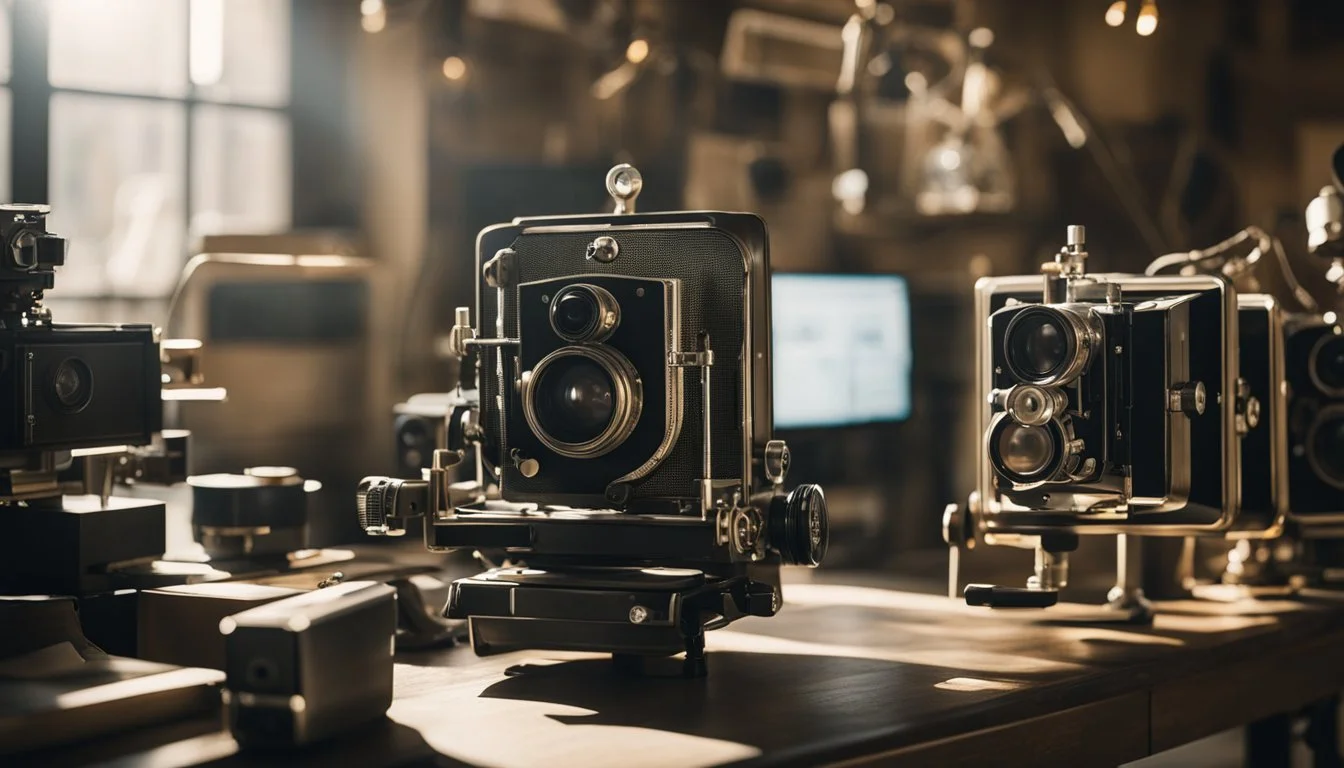D.A. Pennebaker: Pioneering the Cinéma Vérité Revolution and Shaping Documentary Filmmaking
Few filmmakers have impacted the documentary genre as profoundly as D.A. Pennebaker. A pioneer in the cinéma vérité movement, Pennebaker's groundbreaking approach captured the essence of reality without the artificiality of scripted scenes or posed shots. His innovative style is epitomized in works like "Bob Dylan: Don't Look Back" and "The War Room," which offer an unfiltered glimpse into pivotal cultural and political moments.
Pennebaker’s influence extends beyond technique; he documented key moments in music and politics that defined generations. His work on "Primary," co-directed with Robert Drew, stands as a seminal example of direct cinema, showcasing his talent for immersing the audience in authentic, unguarded moments. This method transformed documentaries from mere reportage into compelling narratives that resonate on a deeply human level.
By championing a raw, immersive filming style, D.A. Pennebaker didn't just observe history—he captured its pulse. His legacy continues to inspire modern documentarians to push the boundaries of the genre, ensuring that his revolutionary spirit lives on through each frame.
Early Life and Career of D.A. Pennebaker
D.A. Pennebaker's early years laid the groundwork for his later achievements in documentary filmmaking. His education and early career experiences significantly influenced his eventual transition into the world of cinema.
The Beginnings: Education and Influences
Donn Alan Pennebaker, known as "Penny" to his friends, was born in Evanston, Illinois. His father, John Paul Pennebaker, worked as a commercial photographer, which gave Pennebaker an early exposure to the world of visual arts.
He served in the Navy during World War II, an experience that shaped his discipline and outlook. Following his military service, he studied engineering at Yale University.
This technical background proved invaluable later in his career, particularly when he began experimenting with film equipment and techniques. His technical acumen combined with his artistic influences laid a strong foundation for his pioneering work in documentary filmmaking.
Transition into Filmmaking
Pennebaker's transition from engineering to filmmaking was marked by a series of innovative steps. He co-founded the company Electronics Engineering, where he developed one of the first computerized polling systems. This venture highlighted his knack for leveraging technology.
In the early sixties, Pennebaker teamed up with Richard Leacock, which was a turning point in his career. Together, they left Drew Associates and formed Leacock Pennebaker Inc. in 1963. This collaboration was highly productive and pivotal.
Their use of lightweight, portable cameras and synchronized sound recording was revolutionary at the time. This approach, known as cinéma vérité or direct cinema, allowed them to capture reality more spontaneously and authentically, transforming the landscape of documentary filmmaking.
Development of Cinéma Vérité
The evolution of cinéma vérité was influenced by the theoretical foundations of documentary realism, innovations in film technology, and the collaborative efforts of pioneering filmmakers. These elements collectively helped shape a new documentary style characterized by authenticity and spontaneity.
Conceptual Foundations
Cinéma vérité, meaning “truthful cinema,” originated from the idea that film could capture real life unfiltered and unembellished. Influenced by the earlier work in sociological and ethnographic filmmaking, pioneers like D.A. Pennebaker sought to document events without scripts or staged scenes. This approach was driven by the belief that true understanding of human behavior could be revealed through unobtrusive observation.
Filmmakers aimed to minimize their influence on the subjects, creating a more authentic portrayal of reality. This movement rejected the heavily edited, narrated documentaries that preceded it, striving instead for raw and immediate representation. Notable early works, such as Pennebaker's “Don’t Look Back,” exemplified this ethos by immersing viewers directly into the events being documented.
Technological Advancements
The development of lightweight, portable film equipment was crucial for the emergence of cinéma vérité. In the 1960s, advancements in 16mm cameras and sync-sound technology enabled filmmakers to move freely and unobtrusively. Cameras like the Eclair NPR and the Nagra sound recorder were pivotal in this regard.
These technological innovations allowed documentarians to shoot in real-time and in natural settings. They could follow subjects without the need for large crews or heavy, stationary equipment. This mobility was essential for capturing unscripted, spontaneous moments, and it distinguished cinéma vérité from other styles of documentary filmmaking.
Collaborations and Mentorships
Cinéma vérité thrived through close collaboration among like-minded filmmakers. Pioneers such as D.A. Pennebaker, Richard Leacock, and Albert Maysles often worked together, sharing techniques and philosophies. For instance, the trio collaborated on the landmark documentary “Primary” which showcased their ability to capture the raw, unscripted power of political campaigns.
Mentorship also played a role in fostering new talent and spreading cinéma vérité principles. Experienced filmmakers guided younger directors, instilling the values of unobtrusive observation and real-time storytelling. These partnerships helped sustain the movement and allowed its techniques to evolve beyond its initial practitioners, influencing subsequent generations of documentary filmmakers.
Major Works
D.A. Pennebaker's career is marked by several groundbreaking documentaries that transformed the landscape of non-fiction filmmaking. His films often offered intimate views of their subjects, capturing real-life moments with a unique sense of authenticity.
Don't Look Back
Don't Look Back (1967) is one of Pennebaker's most iconic films. It follows Bob Dylan's 1965 tour of the United Kingdom and is known for its raw, unfiltered portrayal of the artist. The film is celebrated for its candid behind-the-scenes footage, including Dylan's interactions with fans, journalists, and other musicians. Notable scenes, such as the influential opening sequence featuring Dylan's "Subterranean Homesick Blues," reflect Pennebaker's skill in capturing the zeitgeist of the era.
Monterey Pop
Monterey Pop (1968) documented the Monterey Pop Festival, a three-day concert event that marked a pivotal moment in rock music history. The film features performances by legendary artists like Jimi Hendrix, Janis Joplin, and The Who. Pennebaker's footage presents the free-spirited energy and cultural significance of the festival. His ability to capture iconic performances, such as Hendrix setting his guitar on fire, solidified Monterey Pop as a seminal film in the rock documentary genre.
The War Room
Released in 1993, The War Room offers an inside look at Bill Clinton's 1992 presidential campaign. Co-directed by Pennebaker and his wife Chris Hegedus, the film focuses on campaign strategists James Carville and George Stephanopoulos. Through its fly-on-the-wall style, the documentary reveals the intense and often chaotic environment of political campaigning. It is praised for showing the strategic discussions and human emotions behind the scenes, making it a compelling study of modern American politics.
Influence and Legacy
D.A. Pennebaker stands as a towering figure in the evolution of documentary filmmaking, instrumental in championing the cinéma vérité style which imparts a more raw and authentic portrayal of reality. His innovative techniques and groundbreaking works continue to influence filmmakers and shape the industry today.
Influence on Documentary Filmmaking
Pennebaker's influence on documentary filmmaking is profound. He was a pioneer of direct cinema, a style emphasizing unobtrusive filming to present events as they happen without interference. This approach gave documentaries a sense of immediacy and authenticity, making viewers feel like they were part of the action.
His work on films like Don't Look Back and Monterey Pop showcased his ability to capture the spontaneity and essence of cultural icons and events. These films demonstrated the power of cinéma vérité to tell stories in an unfiltered and engaging manner, inspiring future generations of documentarians to adopt his techniques.
Pennebaker's Contributions to Film History
Pennebaker's contributions to film history extend beyond his directorial work. He played a crucial role in evolving the technical aspects of filmmaking. He contributed to the development of lightweight, portable cameras and synchronous sound equipment, allowing for greater mobility and flexibility in film production.
His innovative techniques in editing and narrative structure also set a new standard for documentaries. The Academy of Motion Picture Arts and Sciences recognized these contributions when they honored him with an Academy Honorary Award in 2013. Pennebaker's legacy is reflected in the ongoing influence of his methods on contemporary documentary filmmaking.
Awards and Recognitions
D.A. Pennebaker's contributions to documentary filmmaking have earned him numerous accolades. Among his most notable achievements is the Academy Honorary Award received in 2013 from the Academy of Motion Picture Arts and Sciences. This distinguished honor recognized his pioneering influence in the field of documentary cinema.
Pennebaker's work has also been celebrated by various film festivals. He was the recipient of a Lifetime Achievement Award at the International Documentary Association Awards. This award highlights his enduring impact and dedication to the craft of documentary filmmaking.
In addition to his industry-facing awards, Pennebaker received praise for individual projects. His film "Don't Look Back" was selected for preservation in the United States National Film Registry by the Library of Congress. This selection is a testament to its cultural, historical, and aesthetic significance.
Pennebaker was also honored with the British Academy of Film and Television Arts (BAFTA) Special Award in 2012. BAFTA recognized his innovative work and contributions to the art of documentary filmmaking.
Furthermore, his technical ingenuity in filmmaking was acknowledged with multiple awards from the Directors Guild of America (DGA). These awards reflect his peer recognition within the industry and highlight his influential techniques in cinéma vérité.
Through these varied awards and recognitions, Pennebaker's legacy is cemented as a trailblazer in documentary film, particularly within the realms of direct cinema and cinéma vérité. His innovative techniques and compelling storytelling have left a lasting impact on the genre.
Later Life and Passing
D.A. Pennebaker remained active in his later years, continuing to contribute to the documentary film industry. He collaborated with his wife, Chris Hegedus, producing several notable documentaries that maintained their signature cinéma vérité style.
In 2012, Pennebaker received an Academy Honorary Award for his impactful contributions to the film industry. This recognition highlighted his status as an influential figure in documentary filmmaking.
He spent much of his later life cherishing his legacy and engaging with fans and filmmakers alike. His work inspired a new generation of documentarians who admired his unfiltered approach to storytelling.
Pennebaker passed away on August 1, 2019, at the age of 94. His death marked the end of an era for cinéma vérité. Tributes poured in from across the film and music industries, acknowledging his enduring influence.
His legacy continues through the films he crafted and the techniques he pioneered. Many remember him not just for his films, but for his dedication to capturing the essence of reality.




